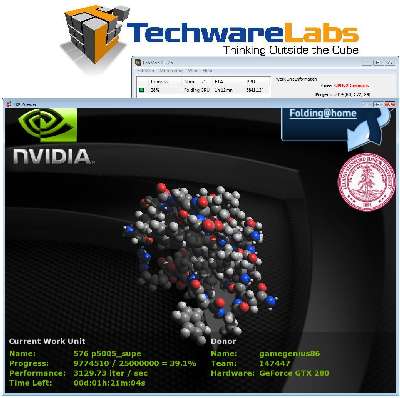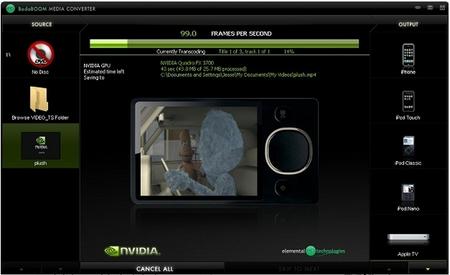|
Palit GTX 280 SLI

Extras:
One thing most people don’t know is that in the GPU there are actually two modes. The most obvious mode is called the graphics mode which will allow you to run you graphical application and games. The mode that most people don’t know about is called the compute mode, so that you can run applications outside of gaming. This mode allows you to use your GPUs processing power to not only display amazing graphics, but to also use to compute various other things. The two main applications that can use this computing power are Folding@Home and RapidHD Video Transcoding.
Folding@home:
Folding@home is a distributed computing project designed to perform computationally intensive simulations of protein folding and other molecular dynamics. Using your own personal computer, you can help by using your computers computational power to help scientists understand protein folding, misfolding, and related diseases.
You can see that in the image above, the application FahMon running in the background is reporting the PPD which is a way to tell how fast the folding process is working. Unfortunately I was only able to run the Folding@Home test on just the Palit GTX280, which received a nice 5841 PPD.
Video Transcoding:
The company Elemental Technologies has now figured out a way to use the nVidia 200 series GPU to sufficiently handle the enormous amount of computation required to perform high quality, high-definition encoding, image processing, and transcoding tasks.
With the RapidHD BadaBoom software by Elemental Technologies you can now take the time intensive task of transcoding videos and do them in significantly less time. An example of this is, if you were trying to transcode a two hour movie on a 1.6Ghz Dual-Core processor it would take anywhere from four to five hours to complete. While on the other hand it would only take ten to fifteen minutes using the nVidia 200 series processor.
I mentioned the term transcoding a few times now, and for those who don't know what this is, it is simple: the conversion of media from one format to another. Why transcode? Well, let’s say you have a video on your computer that you want to transfer over to your Microsoft Zune or your new iPod Touch. Normally this won’t work by simply transferring it over because the file format is not supported on your mobile device. In order to properly transfer it over and work as you intend it to, you will first need to ‘transcode’ your video to work with the supported file formats






